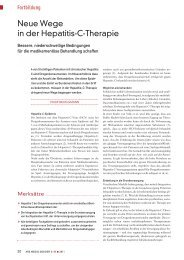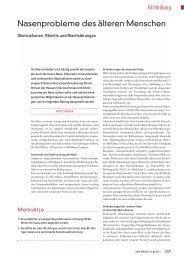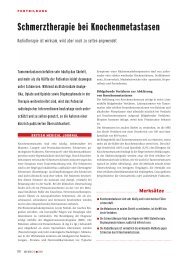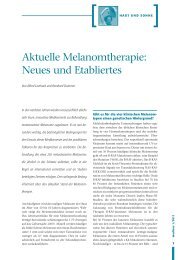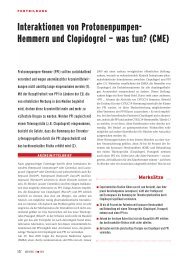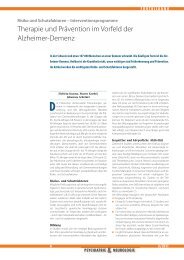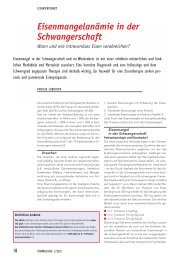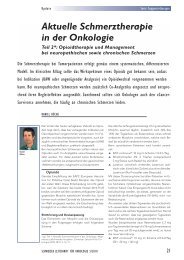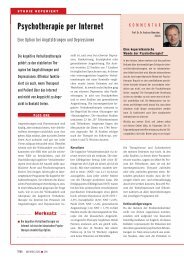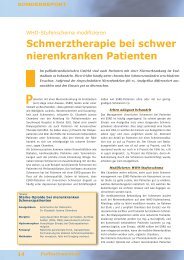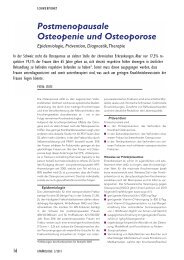Innovative orale Therapien der schubförmigen Multiplen Sklerose
Innovative orale Therapien der schubförmigen Multiplen Sklerose
Innovative orale Therapien der schubförmigen Multiplen Sklerose
Sie wollen auch ein ePaper? Erhöhen Sie die Reichweite Ihrer Titel.
YUMPU macht aus Druck-PDFs automatisch weboptimierte ePaper, die Google liebt.
38<br />
jeweils mehr als 1000 Patienten. Die<br />
Rekrutierung wird Anfang 2009 beendet,<br />
Ergebnisse werden etwa 2011<br />
vorliegen.<br />
Bewertung<br />
Das Sicherheitsprofil von BG00012 ist<br />
günstig und die Verträglichkeit bis auf<br />
gelegentlich therapielimitierende gas t -<br />
rointestinale Nebenwirkungen gut.<br />
Sollte die Phase-III-Studie die Wirksamkeit<br />
<strong>der</strong> Substanz bestätigen, wäre<br />
BG00012 eine interessante Option in<br />
<strong>der</strong> Basistherapie und würde sich gegebenenfalls<br />
auch zur Kombinations -<br />
therapie eignen.<br />
Firategrast<br />
Wirkmechanismus<br />
Firategrast ist eine gegen Alpha4-Integrin<br />
gerichtete, oral verfügbare<br />
neue Substanz. Es hat damit den<br />
gleichen Angriffspunkt wie <strong>der</strong> i.v.<br />
monoklonale Antikörper Natalizumab<br />
(Tysabri ® ). Die Blockade von Alpha4-<br />
Integrin hemmt die Einwan<strong>der</strong>ung<br />
von Leukozyten in das ZNS und kann<br />
so die Inflammation abschwächen.<br />
An<strong>der</strong>s als Natalizumab ist Firategrast<br />
ein «small molecule» mit kurzer Halbwertzeit,<br />
was möglicherweise hinsichtlich<br />
Nebenwirkungen (opportunistische<br />
Infektionen) günstig ist.<br />
Wirksamkeit<br />
Die TIME-Studie ist eine Phase-II-Studie<br />
zur Prüfung <strong>der</strong> Wirksamkeit von<br />
Firategrast bei MS. Die Studie dauert<br />
6 Monate und schliesst eine Nach -<br />
beobachtungsphase von weiteren 6<br />
Monaten ein. Erste Ergebnisse sind<br />
erst 2010 zu erwarten.<br />
Schlussfolgerungen<br />
Neue, <strong>orale</strong> Substanzen können das<br />
Spektrum <strong>der</strong> Therapie <strong>der</strong> <strong>schubförmigen</strong><br />
MS ergänzen und Probleme <strong>der</strong><br />
partiellen Wirksamkeit und des parenteralen<br />
Applikationsmodus <strong>der</strong> gegenwärtigen<br />
Basistherapie möglicherweise<br />
immerhin teilweise lösen.<br />
Solange keine Daten <strong>der</strong> Zulassungsstudien<br />
vorliegen, ist eine endgültige<br />
Bewertung aber pure Spekulation.<br />
Einzig Fingolimod (FTY) hat in <strong>der</strong><br />
Fortbildung<br />
Phase-III-Vergleichsstudie gegen Interferon-beta<br />
1a i.m. bereits angedeutet,<br />
welches Potenzial diese <strong>orale</strong> Therapie<br />
haben kann. Bereits jetzt wird<br />
deutlich, dass potentere Substanzen<br />
aber auch schwerwiegende Nebenwirkungen<br />
haben können, sodass sich<br />
die neue Generation <strong>der</strong> MS-Therapie<br />
nun in einem Spannungsfeld aus Wirksamkeit,<br />
Verträglichkeit und Sicherheit<br />
sowie Patientenfreundlichkeit<br />
beweisen muss. ◆<br />
Korrespondenzadresse:<br />
Dr. med. Özgür Yaldizli<br />
Kantonsspital St. Gallen<br />
Klinik für Neurologie<br />
Rorschacherstrasse 95<br />
9007 St. Gallen<br />
Die Publikation entstand ohne Sponsoring o<strong>der</strong> Einflussnahme<br />
durch die pharmazeu tische Industrie.<br />
Literatur:<br />
1. WHO. Adherence to Long-term Therapies: Evidence<br />
for Action. World Health Organisation<br />
2003.<br />
2. Beutler E. Cladribine (2-chlorodeoxyadenosine).<br />
Lancet 1992; 340: 952–6.<br />
3. Beutler E, Sipe JC, Romine JS et al.: The treatment<br />
of chronic progressive multiple sclerosis<br />
with cladribine. Proc Natl Acad Sci U S A<br />
1996; 93: 1716–20.<br />
4. Romine JS, Sipe JC, Koziol JA et al.: A doubleblind,<br />
placebo-controlled, randomized trial of<br />
cladribine in relapsing-remitting multiple scle -<br />
rosis. Proc Assoc Am Physicians 1999; 111:<br />
35–44.<br />
5. Rice GP, Filippi M and Comi G. Cladribine and<br />
progressive MS: clinical and MRI outcomes of a<br />
multicenter controlled trial. Cladribine MRI Study<br />
Group. Neurology 2000; 54: 1145–1155.<br />
Neurologie 1 2009<br />
6. Fujita T, Inoue K, Yamamoto S et al.: Fungal<br />
metabolites. Part 12. Potent immunosuppressant,<br />
14-deoxomyriocin, (2S,3R,4R)-(E)-2-<br />
7.<br />
amino-3,4-dihydroxy-2-hydroxymethyleicos-6enoic<br />
acid and structure-activity relationships<br />
of myriocin <strong>der</strong>ivatives. J Antibiot (Tokyo)<br />
1994; 47: 216–224.<br />
Billich A, Bornancin F, Devay P et al.: Phosphorylation<br />
of the immunomodulatory drug<br />
FTY720 by sphingosine kinases. J Biol Chem<br />
2003; 278: 47408–47415.<br />
8. Pinschewer DD, Ochsenbein AF, O<strong>der</strong>matt B<br />
et al.: FTY720 immunosuppression impairs effector<br />
T cell peripheral homing without affecting<br />
induction, expansion, and memory. J Immunol<br />
2000; 164: 5761–5770.<br />
9. Webb M, Tham CS, Lin FF et al.: Sphingosine<br />
1-phosphate receptor agonists attenuate relapsing-remitting<br />
experimental autoimmune<br />
encephalitis in SJL mice. J Neuroimmunol<br />
2004; 153: 108–121.<br />
10. Fujino M, Funeshima N, Kitazawa Y et al.:<br />
Amelioration of experimental autoimmune<br />
encephalomyelitis in Lewis rats by FTY720<br />
treatment. J Pharmacol Exp Ther 2003; 305:<br />
70–77.<br />
11. Brinkmann V, Davis MD, Heise CE et al.: The<br />
immune modulator FTY720 targets sphingosine<br />
1-phosphate receptors. J Biol Chem 2002;<br />
277: 21453–21457.<br />
12. Kappos L, Antel J, Comi G et al.: Oral fingolimod<br />
(FTY720) for relapsing multiple sclerosis.<br />
N Engl J Med 2006; 355: 1124–1140.<br />
13. O'Connor P, Comi G, Montalban X et al.: Oral<br />
fingolimod (FTY720) in multiple sclerosis: twoyear<br />
results of a phase II extension study. Neurology<br />
2009; 72: 73–79.<br />
14. Budde K, Schutz M, Glan<strong>der</strong> P et al.: FTY720<br />
(fingolimod) in renal transplantation. Clin<br />
Transplant 2006; 20 Suppl 17: 17–24.<br />
15. O'Connor PW, Li D, Freedman MS et al.: A<br />
Phase II study of the safety and efficacy of teriflunomide<br />
in multiple sclerosis with relapses.<br />
Neurology 2006; 66: 894–900.<br />
16. Tan IL, Lycklama a Nijeholt GJ, Polman CH et<br />
al.: Linomide in the treatment of multiple<br />
sclerosis: MRI results from prematurely terminated<br />
phase-III trials. Mult Scler 2000; 6:<br />
99–104.<br />
17. Polman C, Barkhof F, Sandberg-Wollheim M et<br />
al.: Treatment with laquinimod reduces development<br />
of active MRI lesions in relapsing MS.<br />
Neurology 2005; 64: 987–991.<br />
18. Comi G, Pulizzi A, Rovaris M et al.: Effect of laquinimod<br />
on MRI-monitored disease activity in<br />
patients with relapsing-remitting multiple<br />
sclerosis: a multicentre, randomised, doubleblind,<br />
placebo-controlled phase IIb study. Lancet<br />
2008; 371: 2085–2092.<br />
19. Schimrigk S, Brune N, Hellwig K et al.: Oral fumaric<br />
acid esters for the treatment of active<br />
multiple sclerosis: an open-label, baseline-controlled<br />
pilot study. Eur J Neurol 2006; 13:<br />
604–610.<br />
20. Kappos L, Gold R, Miller DH et al.: Efficacy and<br />
safety of oral fumarate in patients with relapsing-remitting<br />
multiple sclerosis: a multicentre,<br />
randomised, double-blind, placebo-controlled<br />
phase IIb study. Lancet 2008; 372:<br />
1463–7142.



